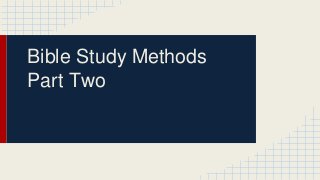
Bible Study Methods Part Two
- 1. Bible Study Methods Part Two
- 2. Duval and Hayes’ Method ● The method of Duval and Hayes’ help the student of the Bible examine the text honestly and straightforwardly. One of the big dangers in reading the Bible is that we see with an understanding from our own culture, instead of as the original writers intended or as an ancient recipient would receive it. ● We call methods of interpretation “Hermeneutics”. I think Duval and Hayes’ Hermeneutic is good because it it walks the reader through a logical process to come to a grounded conclusion. They even explains steps to check your conclusions about a passage to help you make sure you have it right. ● The following slides will walk us through their four step process.
- 3. Grasp the Text in their Town ● This means our first task is to try and understand the passage of scripture as a member of the original audience might understand it. This is very difficult since we are so far removed from the context, but it is essential that we try. ● At this point we want to ask questions like: o Who is writing? o Why are they writing? o What kind of message is it? o What is the tone? Harsh, friendly, encouraging, informative? ● What would an original hearer think about what he or she heard?
- 4. Measure the Width of the River to Cross ● Now you may have had difficulty thinking about the original hearer’s perspective. That’s because there are many cultural differences between the times of the Bible and now. Our task at this point is to think of how much is different! ● Many of the important differences can be summarized by: o Time o Technology o Geography o Nature o Social Norms o Cultural Norms o Covenant Differences ● At this point, write out as many differences as you can think of.
- 5. Crossing over a Bridge ● Once we know what the differences are we can get a better sense of what an ancient person might think about a passage from the Bible. The step of Crossing over a Bridge is the hardest one. At this point we want to take the ideas or concepts of what an original hearer would think, and rephrase it as a universal principle. ● For example, if a story from the Bible shows the faithfulness of a person being rewarded by God, a universal principle might be that God looks favorably on faithfulness. The aspect of reward might be contextual to the passage, but the general principle is true that God finds faith favorable. ● For another example, in Acts 2 the Holy Spirit comes upon the disciples with great power and visible signs. The passage wasn’t written to show how the Holy Spirit always comes on people. They had lived their lives up to this point without the Holy Spirit in them! That’s really different! The passage was likely written to show the beginning of the church and that the Holy Spirit works in the people of the church. If we don’t take note of the differences or the purpose of a passage, we become liable to misinterpretation. Noting these differences helps us get to the important and universal truths!
- 6. Grasping the Text in our Town ● Now the question is, how do we apply this universal truth to our lives? ● To do this we must remember to stick to the universal truths, and not to spiritualize, allegorize, or exemplarize the passage we are looking at. For example, if we tried to tell people to gather for dinners and pray for the Holy Spirit to come in fire and windstorm like in Acts 2, we’d be setting people up for disappointment. We know from the rest of Acts and the NT that the Holy Spirit didn’t come on people in this way anymore. It’s not the point of the passage. It’s not a universal truth of the passage. It’s not a part of the passage we should be applying to our lives. ● Instead we should take truths like “The Holy Spirit works to build God’s church” as we see in Acts 2 (and the rest of the book) and apply that truth to life. Perhaps the application from a chapter like this is to observe in who and where the Holy Spirit is especially working in the church and move efforts and resources to these areas of ministry.
- 7. Duval and Hayes’ book ● This method is what I learned in my time in Bible College (Moody!). It’s such a good method that has stuck with me for years that I still like to teach and recommend it. ● If you want to learn more about this method and get an in-depth understanding, check out their book Grasping God’s Word.